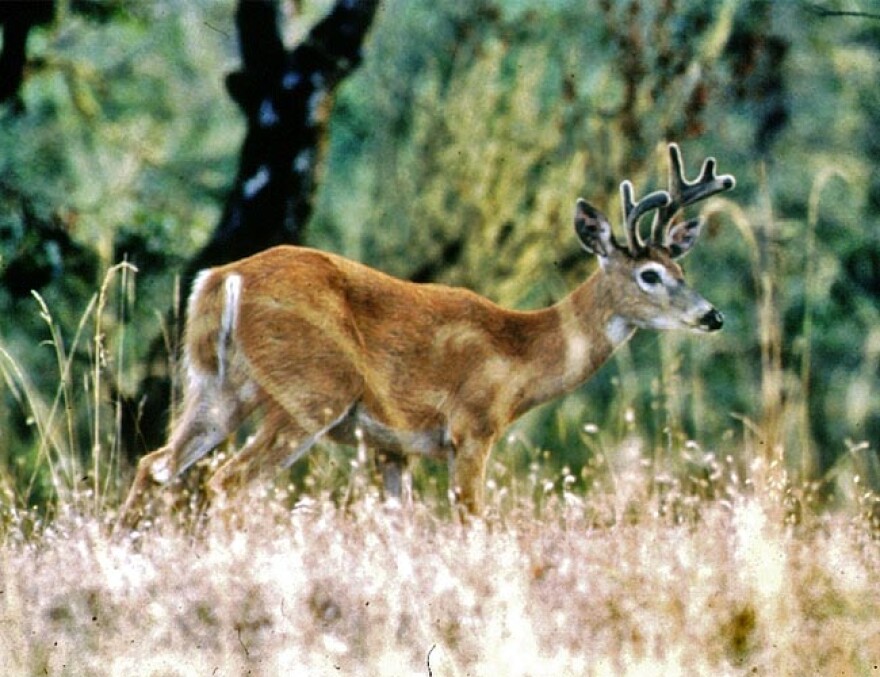More white-tailed deer are dying in the Northwest of viruses that often cause more die-offs after hot summers and droughts.
While numbers could continue to climb, lab testing has found more white-tailed deer than normal have been infected with either bluetongue or epizootic hemorrhagic disease, known as EHD.
Deer contract both viruses from biting gnats, commonly known as “no-see-ums.” During hot summers, many watering holes shrink, exposing the mud where the gnats live. The gnats can survive in water pools as small as hoofprints, according to the Oregon Department of Fish and Wildlife.
When deer have trouble finding water, they congregate in lowland areas. That provides ample sources for the gnats to bite, said Kevin Snekvik, with the Washington Animal Disease Diagnostic Laboratory at Washington State University.
“You have a bunch of animals that are close together, and so the midges don't have to go very far to find their next victim, per say,” Snekvik said.
The diagnostic lab tests samples to see if a deer is positive for either virus. The diseases caused by the viruses can’t spread from deer-to-deer, nor are they harmful to people, he said.
Nevertheless, the Washington Department of Fish and Wildlife recommends hunters avoid shooting deer that appear to be sick.
The diseases are often fatal to deer, Snekvik said. White-tailed deer particularly are susceptible.
The outbreaks can come in cycles, he said. Once a population is infected, it may develop immunity, but that immunity doesn’t pass on to fawns.
“Your population starts having more and more animals that are susceptible to the virus because they don't have any immunity developed,” Snekvik said.
That, combined with drought years increasingly caused by climate change, can lead to larger outbreaks, he said.
Kristin Mansfield, Washington state veterinarian, said EHD and bluetongue viruses affect deer in the same way.
The difference, she said, is that EHD almost exclusively affects white-tailed deer. Rarely, EHD will spillover into domestic cattle. Bluetongue affects deer and bighorn and domestic sheep, she said.
Most summers, Mansfield said she gets reports of suspected cases in the middle of August, and reports slow at the end of October. The first hard freeze kills off the biting gnats.
“When I got the first report this summer, I looked at the calendar, and it was Aug. 16. My thought was, ‘Oh, boy. Here we go. Right on schedule,’” Mansfield said.
Reports of diseased deer have come in from east of the Cascade Mountains, including Spokane Valley, Deer Park, Colfax, and Davenport.
Anecdotally, children at the First Hunt workshop near Kettle Falls reported seeing a deer suspected to have died from bluetongue. The workshop, held the last weekend in August, taught children and teens about conservation and hunting.
An experienced hunter and a young mentee snapped a picture of the deer they suspected fell victim to bluetongue disease during a hike along a ridge.
“We weren’t sure if it was bluetongue. We saw a diseased deer. He wasn’t attacked or anything,” said mentee Ethan Hatzke, 14, of Spokane.
In 2015, another bad drought year, Annemarie Prince, a wildlife biologist with the Washington Department of Fish and Wildlife, said a large number of deer died, including more than 80 in the city limits of Colville in northeastern Washington.
Prince said she’s anticipating this year could be similar to the die-offs in 2015, unless a hard frost happens soon.
Snekvik said EHD seems to be the most prevalent virus showing up in deer this summer.
Biologists also reported an EHD outbreak in Idaho’s Kamiah and Clearwater areas this summer. Idaho Fish and Game reported around 250 to 300 white-tailed deer died in August.
Oregon is also seeing an increase in deer mostly infected with EHD, said Colin Gillin, state wildlife veterinarian with the Oregon Department of Fish and Wildlife.
In 2020, Gillin said, the Oregon department shut down hunting season in the Blue Mountains because an estimated 2,000 deer died of EHD.
“There weren't any deer there to have hunters go out and spend their time on, so EHD can hit deer pretty hard,” Gillin said. “You just really have to keep an eye on it and try to track it. There's nothing you can do about it.”
This year, the department also had reports of diseased black-tailed deer in Central Oregon, which is a little unusual, Gillin said. The viruses more often affect white-tailed deer, he said.
“We expect it. We've seen it more and more and more over the last 10 years, the more that we've had drought conditions increase,” Gillin said.
That’s a concern, Snekvik said, as climate change makes drought conditions more frequent and summers warmer, which could mean more instances of EHD and bluetongue.
Moreover, he said he’s seen increased rates of other zoonotic diseases, such as West Nile virus, which affects horses and sometimes people. That’s because summer conditions are becoming more favorable for the mosquitos that carry the virus.
West Nile first arrived in the Columbia Basin. Now, it’s been found in North Idaho and near the Canadian border, he said.
“We're seeing that over time, that virus moves farther north, probably because the mosquitoes are carrying it farther because they can survive up there,” Snekvik said.


